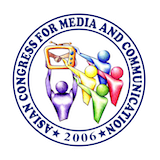Shifting the dynamics in popular culture on Islamophobic media narratives
ACMC2021
Abstract
Prior to the Christchurch mosque massacres on 15 March 2019, studies on New Zealand media showed that representations of Islam and Muslims were largely negative. Muslims were depicted as terror-prone and a threat to democracy and free speech. This popular media culture of negative framing is not unique to New Zealand as global media studies show a consistent and disproportionately high negative labelling of Islam and Muslims compared with adherents of other faiths. This article focuses on the role of the government and media to shift the dynamics in popular culture in Islamophobic media narratives. A critical analysis of the actions of these powerful sectors at the Conference on Countering Terrorism and Violent Extremism (CTVE) in 2021 showed an opportunity to address issues management and culture competence that could change the way Muslims and Islam perceived and represented the media.
Downloads
Metrics
References
Ahmed, S., & Matthes, J. (2017). Media representation of Muslims and Islam from 2000 to 2015: A meta-analysis. International Communication Gazette, 79(3), 219-244. https://doi.org/10.1177/1748048516656305 DOI: https://doi.org/10.1177/1748048516656305
Cheng, D., & Leask, A. (2020, April 2). Outgoing police commissioner Mike Bush opens up about police bias, tragedy and trauma counselling. The New Zealand Herald. https://www.nzherald.co.nz/nz/outgoing-police-commissioner-mike-bush-opens-up-about-police-bias-tragedy-and-trauma-counselling/K5JOL2RQ3FCHQ62J7OWPGMQRIE/
Editorial: Passing connections do not radicalise a mosque. (2014, June 7). Stuff.co.nz. http://www.stuff.co.nz/the-press/opinion/editorials/10129571/Editorial-Passing-connections-do-not-radicalise-a-mosque
Eid, M. (2014). Perceptions about Muslims in western societies. In M. Eid and K. H. Karim (Eds.). Re-imagining the other culture, media, and western-Muslim intersections. New York, NY: Palgrave Macmillan DOI: https://doi.org/10.1057/9781137403667_6
FIANZ. (2020). Evidence-based Synthesis. FIANZ Submission to the Royal Commission of Inquiry into the Attack on Christchurch Mosques. Federation of Islamic Associations of New Zealand. FIANZ-RC-FORMAL-SUBMISSION-24-February-2020-FINAL-VERSION-Autosaved.pdf
Fitch, K., & Motion, J. (2018). Popular culture and social change: The hidden work of public relations. London, UK: Taylor and Francis Group.
Johnson, K.A., & Taylor, M. (2018). Engagement as communication: Pathways, possibilities, and future directions (pp. 1-15). In K.A. Johnson & M. Taylor (eds.). The handbook of communication engagement. Hoboken, NJ: John Wiley & Sons, Inc. DOI: https://doi.org/10.1002/9781119167600.ch1
Mathewson, N. (2014, June 4). Killed terrorists radicalised in Christchurch. Stuff.co.nz. Retrieved from https://www.stuff.co.nz/national/10118134/Killed-terrorists-radicalised-in-Christchurch
Morey, P., Yaqin, A., & Forte, A. (2019). Contesting Islamophobia: Anti-Muslim prejudice in media, culture and politics. London, UK: I. B. Tauris & Company Limited
Neiwert, D., Ankrom, D., Kaplan, E., & Pham, S. (2017, June 22). Homegrown terror: Explore 9 years of domestic terrorism plots and attacks. The Investigative Fund. Retrieved from https://apps.revealnews.org/homegrown-terror
Oddo, J. (2018). The discourse of propaganda: Case studies from the Persian gulf war and the war on terror. Philadelphia, PA: The Pennsylvania State University Press. DOI: https://doi.org/10.1515/9780271082752
OnePath Network (2017). Islam in the media. Retrieved from https://onepathnetwork.com/islam-in-the-media-2017
Otago Daily Times (2016, January 8). Jihadi bride’ fears over Kiwi women. Retrieved from www.odt.co.nz/news/national/jihadi-bride-fears-over-kiwi-women
Pinfari, M. (2019). Terrorists as monsters: The unmanageable other from the French revolution to the Islamic state. Oxford Scholarship. https://doi.org/10.1093/oso/9780190927875.001.0001 DOI: https://doi.org/10.1093/oso/9780190927875.001.0001
Pitard, J. (2017, September 10). A journey to the centre of self: Positioning the researcher in autoethnography, Forum: Qualitative Social Research, FQS 18(3). (ISSN 1438-5627).
Rahman, K. A. (2016). Dialogue and persuasion in the Islamic tradition: Implications for journalism. Global Media Journal: Canadian Edition, 9(2), 9-26.
Rahman, K. A. (2020). News media and the Muslim identity after the Christchurch mosque massacres. Kotuitui: New Zealand Journal of Social Sciences Online, 15(2), 360–384. https://doi.org/10.1080/1177083X.2020.1747503 DOI: https://doi.org/10.1080/1177083X.2020.1747503
Rahman, K. A., & Emadi, A. (2018). Representations of Islam and Muslims in New Zealand media. Pacific Journalism Review, 24(2), 166-188. https://doi.org/10.24135/pjr.v24i2.419 DOI: https://doi.org/10.24135/pjr.v24i2.419
Royal Commission Inquiry Report (2020). https://christchurchattack.royalcommission.nz/the-report/
Royal Commission of Inquiry Summary of Submissions (2020). https://christchurchattack.royalcommission.nz/publications/v2-summary-of-submissions/
Salahshour, N., & Boamah, E. (2020). Perceived discrimination as experienced by Muslims in New Zealand universities. Journal of Muslim Minority Affairs, 40(3), 497-512. https://doi.org/10.1080/13602004.2020.1819130Statista (2020). Digital Economy Compass 2020. https://www.statista.com/study/83121/digital-economy-compass/#professional DOI: https://doi.org/10.1080/13602004.2020.1819130

Copyright (c) 2022 Khairiah A Rahman

This work is licensed under a Creative Commons Attribution-NonCommercial 4.0 International License.















